Mad days in the court of King Donald
Washington DC -- Standing a sofa's length from President Donald Trump in the Oval Office, I realized I was listening to the leader of the free world rage on the subject of jockstraps.
Jockstraps -- did he really mean that? He did.
As so often before in this job of White House correspondent, I felt my eyes bulge in amazement. Then I took a deep breath, refocused, and tried to speed up my note taking. After all, it was just another day in the Trump White House.
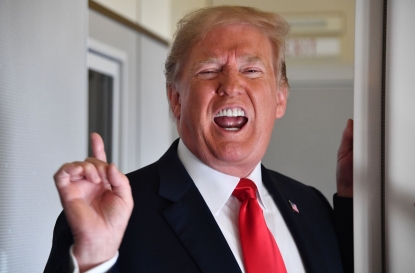 US President Donald Trump speaks to the press aboard Air Force One on September 7, 2018. (AFP / Nicholas Kamm)
US President Donald Trump speaks to the press aboard Air Force One on September 7, 2018. (AFP / Nicholas Kamm)The residence of the US president, affectionately dubbed the “people’s house,” is designed to exude a kind of stately calm.
 The White House during a calm moment, November 26, 2018. (AFP / Nicholas Kamm)
The White House during a calm moment, November 26, 2018. (AFP / Nicholas Kamm)Those neoclassical columns, majestic windows and immaculate paint job (a shade called "whisper white") speak of harmony. Inside, it feels like walking through a museum or an aristocratic home until you remind yourself that it's really an office building with living accommodations attached.
But calm? Calm has been in short supply in the era of Trump, the brash accidental president, and it's even rarer now that he faces impeachment proceedings in the Democratic-led lower house of Congress.
The White House's holy of holies is the Oval Office, an elegant room that probably has witnessed more world-changing decisions and profound geopolitical debate than any other on the planet.
Yet when we reporters are brought into this inner sanctum to see Trump greeting foreign leaders or other VIPs, the former reality television star and real estate tycoon invariably transforms humdrum photo-ops into wild press conferences or what I'd more accurately call performances.
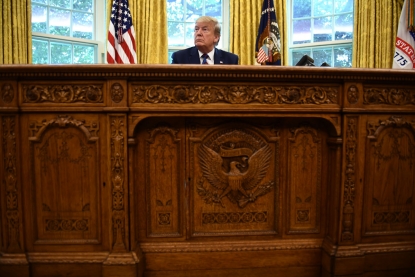 The holiest of holies in the holiest of holies -- the Resolute Desk in the Oval Office, July 26, 2019.
(AFP / Brendan Smialowski)
The holiest of holies in the holiest of holies -- the Resolute Desk in the Oval Office, July 26, 2019.
(AFP / Brendan Smialowski)The scene is always the same:
Trump holds court in front of the famous fire place or behind the massive Resolute Desk. The guest, by now pretty much forgotten, sits or stands awkwardly nearby. And we, maybe 20 or so photographers and reporters, cram around the space in the middle where the sofas are, listening to the president let rip on whatever seems to cross his mind.
Which is how I found myself hearing the jockstrap speech.
The visiting victim this time was the president of Finland, Sauli Niinisto, sitting at Trump’s side and resembling the proverbial man kidnapped by aliens. He'd come over to talk about the Arctic and 5G technology but there he was listening to his host fume about impeachment and, yes, male athletes' underwear.
To be specific, Trump was airing the opinion that his Democratic congressional nemesis Adam Schiff was unworthy so much as to touch the jockstrap of White House loyalist Mike Pompeo, the secretary of state.
Not that he said this quite as clearly.
The full rambling quote was: "He can't, you know, there's an expression: he couldn’t carry his blank strap. I won't say it because they'll say it was so terrible to say. But that guy couldn’t carry his blank strap. You understand that?"
It's a safe bet that Niinisto, despite speaking excellent English, may not have understood.
Throughout Trump's musings on impeachment -- a sometimes painful 17 minutes -- the Finnish visitor sat almost motionless. Only his twitching, rolling eyes gave away his discomfort.
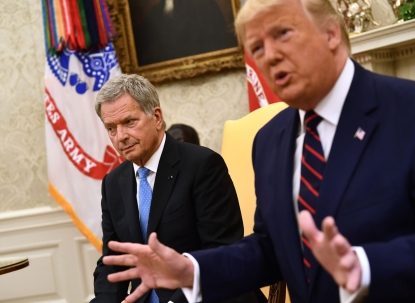 US President Donald Trump meets with Finland's President Sauli Niinisto in the Oval Office of the White House on October 2, 2019 in Washington, DC. (AFP / Brendan Smialowski)
US President Donald Trump meets with Finland's President Sauli Niinisto in the Oval Office of the White House on October 2, 2019 in Washington, DC. (AFP / Brendan Smialowski)And he still had a joint press conference in the ceremonial East Room to get through.
There, Trump got so angry at a reporter's impeachment question that he appeared to channel Travis Bickle, the psychotic anti-hero of the movie "Taxi Driver," set in the president's hometown of New York.
"Are you talkin' to me?" he snapped.
 You talkin' to me? -- US President Donald Trump sits with children during a tour of Nationwide Children's Hospital August 24, 2018 in Columbus, Ohio. (AFP / Brendan Smialowski)
You talkin' to me? -- US President Donald Trump sits with children during a tour of Nationwide Children's Hospital August 24, 2018 in Columbus, Ohio. (AFP / Brendan Smialowski)Visiting the interior of the White House is a frequent part of the job. There's no getting blasé, though. To leave our dank press wing for a session in the Oval, the Cabinet Room, Roosevelt Room, the Diplomatic Reception Room, the East Room, or maybe passing through the Green and Red Rooms, is to enter the heart (at least one part) of America. I'm thrilled every time.
On occasion, when being made to wait for an event, I have time to examine the wonderful murals, portraits, sculptures and paintings of American landscapes. All that art, collected over generations of presidential leadership, speaks to the best side of politics here -- the amazing ambition and hope and high-mindedness of a country that has always looked for renewal and always believed in the possibility of becoming better.
All that sounds a bit naïve now, of course. Bitter, cynical days have descended on the land of eternal optimism.
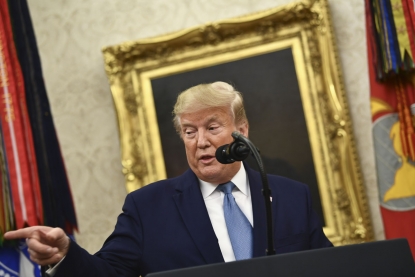 US President Donald Trump at the Oval Office, October 8, 2019. (AFP / Brendan Smialowski)
US President Donald Trump at the Oval Office, October 8, 2019. (AFP / Brendan Smialowski)In fact, perhaps the most salient architectural detail of the White House at present is the ongoing work to double the height of the black iron perimeter fence. The job was planned long ago, but when the president is under siege, well… you see where this goes.
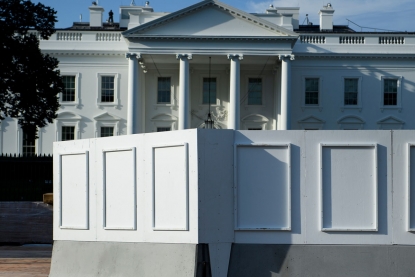 A temporary wall is seen on Pennsylvania Avenue as preparations are made to replace the fence surrounding the White House on July 16, 2019, in Washington, DC. (AFP / Brendan Smialowski)
A temporary wall is seen on Pennsylvania Avenue as preparations are made to replace the fence surrounding the White House on July 16, 2019, in Washington, DC. (AFP / Brendan Smialowski)And he is under siege.
After two years of flailing impotently after a man they see as having trashed the presidency and much of America with it, Democrats believe they finally have Trump cornered with allegations that he pressured Ukraine to dig up dirt on one of his 2020 Democratic rivals, Joe Biden.
Trump being Trump, he not only resists these claims. He has turned the fight into a kind of political version of those absurd wrestling spectacles where fighters with made-up names perform cartoon violence for screaming fans.
It's ugly and will get uglier.
 US President Donald Trump at a press conference in the East Room of the White House, October 2, 2019. (AFP / Saul Loeb)
US President Donald Trump at a press conference in the East Room of the White House, October 2, 2019. (AFP / Saul Loeb)Trump says what's really happening is a "coup." He accuses one of the most senior members of Congress, Democrat Adam Schiff, of "treason." He hints at execution for the anonymous source behind a whistleblowing report on his Ukraine dealings, fondly recalling the way that “spies” were dealt with "in the old days."
He retweets about the risk of civil war. He blurts out to his 65 million Twitter followers that impeachment is "BULLSHIT."
The wackier the rhetoric gets the more I'm reminded of the last impeachment drama I covered -- the abrupt removal from power of Brazil's leftist president Dilma Rousseff in 2016. She also repeatedly claimed that a "coup" was underway, replacing a decade of leftist rule with a series of increasingly rightwing governments.
But Brazil was easy to dismiss as a dysfunctional country where wild swings are just part of the fabric.
The United States isn’t supposed to be like that.
Right?
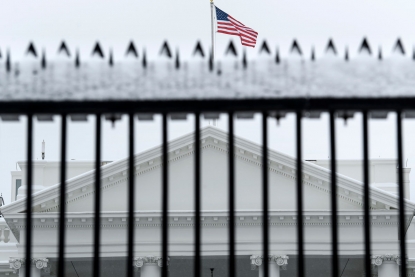 (AFP / Brendan Smialowski)
(AFP / Brendan Smialowski)As the mood darkens, what used to be whispers have become shouts in certain corners of Washington: that the president is actually mad.
"Congress should make extensive use of experts—psychologists and psychiatrists," one of Donald Trump's most outspoken foes, lawyer George Conway, who just happens to be married to top Trump aide Kellyanne Conway, wrote this month.
The most powerful man in the world, eagerly responds in kind. "Stone cold crazy!" he says of his critics. "Nuts!"
So at least everyone in this divided city agrees there's insanity.
 Unhinged, the new tell-all book by former White House aide Omarosa Manigault Newman, is for sale at the Politics and Prose bookstore in Washington, DC, on August 14, 2018. (AFP / Saul Loeb)
Unhinged, the new tell-all book by former White House aide Omarosa Manigault Newman, is for sale at the Politics and Prose bookstore in Washington, DC, on August 14, 2018. (AFP / Saul Loeb)But how on earth can journalists adequately cover this kind of rhetoric?
We're taught to be sober observers. Be balanced. Give both sides. Report facts. So what do you do when accusations of madness are tossed around at the highest level?
The scene during Niinisto's visit drew more than a few astonished looks from the traveling Finnish press. For White House regulars, however, this was pretty much a normal abnormal day.
Having killed off the old custom of daily briefings by a professional press secretary, Trump has become his own spokesman. And for all his constant demonization of journalism, he doesn't seem to be able to get enough of us.
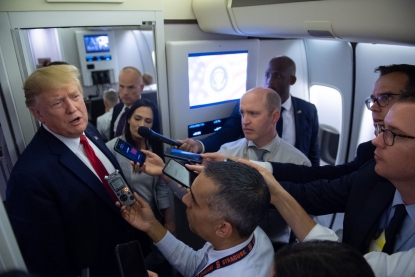 US President Donald Trump speaks to the media aboard Air Force One, August 7, 2019. (AFP / Saul Loeb)
US President Donald Trump speaks to the media aboard Air Force One, August 7, 2019. (AFP / Saul Loeb)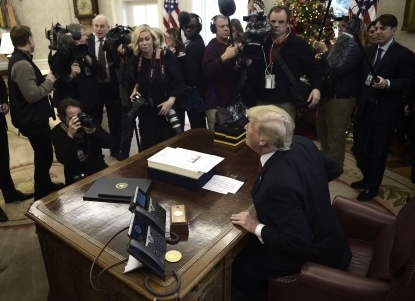 United States President Donald J. Trump speaks to the press in the Oval Office, December 22, 2017. (AFP / Brendan Smialowski)
United States President Donald J. Trump speaks to the press in the Oval Office, December 22, 2017. (AFP / Brendan Smialowski)
Whether in the Oval or anywhere else, Trump adores the back-and-forth. Most spectacular of all are the sessions he runs with reporters and camera crews before boarding the Marine One helicopter on the South Lawn.
Previous presidents would typically stride past the wall of journalists, wave and get on the chopper. But Trump almost always stops to talk -- and talk and talk.
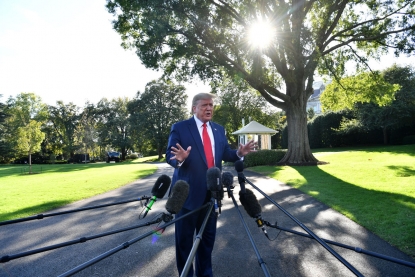 Holding forth on the South Lawn, October 10, 2019.
(AFP / Nicholas Kamm)
Holding forth on the South Lawn, October 10, 2019.
(AFP / Nicholas Kamm)Depending on his mood, he may stay out there 10 minutes. Or 20 or 40. In the cold, or rain, or brutal summer heat, he rarely misses the opportunity to hold forth, sometimes going on for so long that reporters, half-deafened by the sound of the waiting helicopter, could be forgiven for wishing he'd stop.
Just don’t think of these as press conferences in the normal sense of the term.
Pacing along the line of reporters, Trump will accept any question but just as easily he may walk away, giving no answer. The abandoned reporter will be able to do nothing but sputter.
Follow ups are near impossible. Often it's also impossible to hear clearly what the president just said — and he could have said almost anything.
Did he just threaten new tariffs on China? Did he just call a journalist's question "stupid?" Did he really just claim he could kill 10 million people in Afghanistan within days if he wanted and without using nuclear weapons?
At some point he has said all those things out on the lawn -- and more.
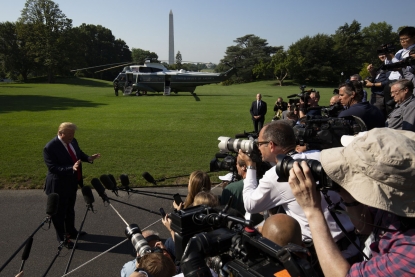 Holding forth on the South Lawn, July 30, 2019.
(AFP / Alastair Pike)
Holding forth on the South Lawn, July 30, 2019.
(AFP / Alastair Pike)We all know that journalists are meant to set aside entirely their personal agendas. That's easy to say.
As a young reporter covering the first war between Russia and Chechen rebels in the mid 1990s, I found it impossible not to sympathize massively with the civilians suffering from war crimes ordered by an inept, corrupt Kremlin. Because I was what we'd now call "embedded" with the outgunned rebel fighters, it was also hard not to sympathise with them. After all, they were, on the whole, risking their lives in reaction to the brutality brought by the Russian state.
With retrospect, I have no doubt that influenced my coverage.
I mean, I did everything I could to be professional. Many of my colleagues risked their lives (and some lost them) to do their job as well as possible.
But for all that risk taking, did we see clearly? What about the radical Islamists spreading their tentacles into the independence movement? What about the criminal elements piggybacking on the rebellion? What about the Russian soldiers, often conscripts in their late teens, who of course bled just as much as any Chechen when hit? On a bigger scale, what about Moscow's understandable argument that no country could put up with an armed rebellion on its territory?
When covering dramas like that, objectivity is beyond difficult.
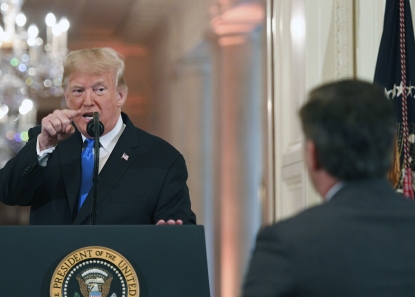 US President Donald Trump in a confrontation with CNN journalist Jim Acosta during a press conference in the East Room of the White House in Washington, DC on November 7, 2018. (AFP / Jim Watson)
US President Donald Trump in a confrontation with CNN journalist Jim Acosta during a press conference in the East Room of the White House in Washington, DC on November 7, 2018. (AFP / Jim Watson)The Trump phenomenon is of course not war. But passions are running high and for many in the media here, the challenges in coverage are just as great.
Not infrequently I hear American journalists privately expressing genuine fear at the way their country is going. Despair almost. And Trump encourages splits through the US media by seeking to turn Fox News into his personal channel, even if many of the network's on-the-ground reporters are highly professional (often earning public reprimands from the commander in chief). Almost daily he rails against the rest of us as "fake," "corrupt" and "bad."
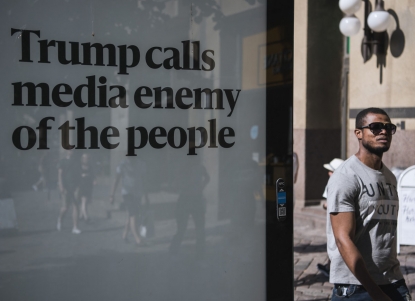 Changing times... A sign in Helsinki, Finland says what the US president called the media on the sidelines of a meeting between him and Russian counterpart Vladimir Putin, July 16, 2018. The term "enemy of the people" was widely used during the wave of terror in Russia and the rest of the Soviet Union when dictator Josef Stalin was in power.
(AFP / Jonathan Nackstrand)
Changing times... A sign in Helsinki, Finland says what the US president called the media on the sidelines of a meeting between him and Russian counterpart Vladimir Putin, July 16, 2018. The term "enemy of the people" was widely used during the wave of terror in Russia and the rest of the Soviet Union when dictator Josef Stalin was in power.
(AFP / Jonathan Nackstrand)I'm half-American but have spent so long at AFP covering other people's stories that I'm able to approach this as another foreign country. At the same time, you mustn't become so detached that you become cynical. You can miss the story that way too.
So I try to remember that US history has been full of extreme twists and that what looks like chaos at times could also be called freedom. I try to remember other stories I've covered around the world where, with time, I've seen how I could have done a better job. I remind myself that you have to be humble as a journalist. You have to admit you don't really have the answers. That's not your job.
You have only questions.
And the one thing which getting close up to Trump allows me to understand is that unlike many politicians, he wears no mask. Trump only plays one role: Trump.
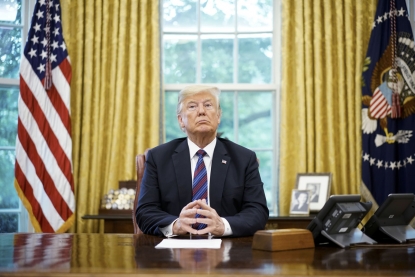 US President Donald Trump at the Oval Office on August 27, 2018, as he speaks on the phone with Mexico's President Enrique Pena Nieto.
(AFP / Mandel Ngan)
US President Donald Trump at the Oval Office on August 27, 2018, as he speaks on the phone with Mexico's President Enrique Pena Nieto.
(AFP / Mandel Ngan) US President Donald Trump at the Oval Office on August 27, 2018 as he speaks by phone with Mexico's President Enrique Pena Nieto.
(AFP / Mandel Ngan)
US President Donald Trump at the Oval Office on August 27, 2018 as he speaks by phone with Mexico's President Enrique Pena Nieto.
(AFP / Mandel Ngan)
I try to remember this, because authenticity is perhaps Trump's greatest strength, the reason fundamentally that he retains passionate support from his voter base even as he sinks deeper into scandal.
Critics call the spectacles we see in the White House as proof of an unruly, even unworthy president. They point to his grammatical weirdness, the way he speaks about himself in the third person, his cursing and name-calling.
"Embarrassing" and "unhinged" are just two of the adjectives frequently applied.
Supporters, though, are thrilled.

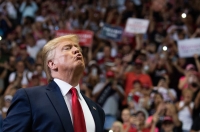
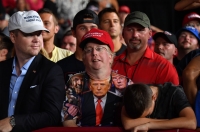
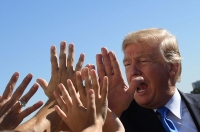

To them, the tearing up of decorum and rules (and laws, according to opponents) proves that Trump isn't yet another hypocritical politician. Regardless of his wealth, he speaks and thinks just like a lot of the blue collar folk showing up to his raucous rallies.
It's a maverick style, these backers say, that has allowed Trump to tackle problems other presidents didn't dare touch.
They point to his attempt to bypass decades of stalemate with North Korea by forging an unlikely "love," as he calls it, with young dictator Kim Jong Un. They point to his cliff-edge trade negotiations with China. They say his sometimes brutal rhetoric on immigration isn't racist, but bravely realistic.
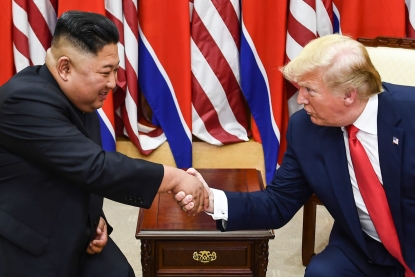 North Korea's leader Kim Jong Un (L) and US President Donald Trump shake hands during a meeting on the south side of the Military Demarcation Line that divides North and South Korea, in the Joint Security Area (JSA) of Panmunjom in the Demilitarized zone (DMZ) on June 30, 2019. Trump is the first US president to have met a leader of North Korea. (AFP / Brendan Smialowski)
North Korea's leader Kim Jong Un (L) and US President Donald Trump shake hands during a meeting on the south side of the Military Demarcation Line that divides North and South Korea, in the Joint Security Area (JSA) of Panmunjom in the Demilitarized zone (DMZ) on June 30, 2019. Trump is the first US president to have met a leader of North Korea. (AFP / Brendan Smialowski)Of course, all those claims are highly debatable. However, they appear true to swaths of the country.
So Democrats in Congress may feel their hearts pounding in anticipation of a Trump downfall. But at the other end of Pennsylvania Avenue, I see a president brimming with freakish self-belief.
The man who previously boasted about possessing a "very, very large brain" has just in the last few days flagged his "great and unmatched wisdom," not to mention his "very stable genius." He is not easily embarrassed.
 US President Donald Trump on the Oval Office, March 6, 2019. (AFP / Saul Loeb)
US President Donald Trump on the Oval Office, March 6, 2019. (AFP / Saul Loeb)And as Democrats have discovered repeatedly since Trump beat the establishment favorite Hillary Clinton in 2016, that kind of personality is very hard to fight against.
"I sort of thrive on it," he says of impeachment.
He better. Otherwise he might need that big new fence they're putting up around the White House.
 The fighting president. US President Donald Trump on the South Lawn, August 4, 2017. (AFP / Saul Loeb)
The fighting president. US President Donald Trump on the South Lawn, August 4, 2017. (AFP / Saul Loeb)



